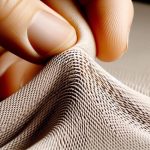You might have heard that wearing silk can soothe sensitive skin, but what about viscose rayon? If you struggle with eczema, choosing the right fabric matters more than you think. Viscose rayon feels soft and smooth, but does that mean it’s truly gentle on eczema-prone skin? Before you decide, it’s important to understand how this fabric interacts with your skin’s unique needs—and whether it could help or harm your comfort.
Table of Contents
Key Takeaways
- Viscose rayon’s soft, smooth texture reduces friction, making it potentially suitable for eczema-prone skin.
- Chemical residues from production may irritate sensitive skin, so low-chemical or organic viscose is preferable.
- The fabric offers moderate breathability and moisture absorption, helping to prevent skin dryness and irritation.
- Individual reactions vary; patch testing new viscose garments is important to ensure no adverse skin response.
- Alternatives like cotton, bamboo, and linen may be better hypoallergenic choices for eczema-prone individuals.
Understanding Viscose Rayon and Its Properties
Viscose rayon is a semi-synthetic fiber made from natural cellulose, usually derived from wood pulp.
Viscose rayon blends natural cellulose with chemical processing to create a versatile, semi-synthetic fabric.
When you look at viscose properties, you’ll notice it combines natural and synthetic qualities. Its fabric composition involves chemically treating cellulose to create a soft, breathable material that drapes well.
You’ll find viscose feels smooth and cool against your skin, similar to cotton or silk. It absorbs moisture effectively, which helps keep you comfortable.
However, because it’s processed chemically, viscose can be less durable than pure natural fibers. Knowing these viscose properties helps you understand why it’s popular in clothing and home textiles.
When you choose viscose rayon, you get a fabric that balances natural comfort with versatile performance.
How Viscose Rayon Interacts With Eczema-Prone Skin
Although fabrics can affect skin health in various ways, those with eczema-prone skin need to be especially careful about what they wear.
Viscose rayon often shows good fabric compatibility for many because it’s soft and smooth, reducing friction against your sensitive skin. However, your skin sensitivity can vary, so it’s important to monitor how your skin reacts to viscose.
Some people find that viscose doesn’t irritate their eczema, while others may notice mild discomfort depending on the fabric’s treatment or blend. Choosing 100% viscose or viscose blends without harsh chemicals can help maintain fabric compatibility with your skin’s needs.
Ultimately, paying attention to how viscose interacts with your eczema-prone skin will guide you in selecting comfortable clothing that minimizes flare-ups.
Moisture Management and Breathability Benefits of Viscose
Understanding how viscose interacts with your skin is just one part of choosing the right fabric for eczema-prone skin.
Choosing the right fabric for eczema-prone skin starts with understanding how it interacts with your skin.
When it comes to moisture management, viscose offers moderate moisture retention, helping keep your skin from drying out without trapping sweat. This balance makes it a good option if you want to avoid the discomfort of overly damp or dry skin.
In a breathability comparison with synthetic fabrics like polyester, viscose performs better, allowing air to circulate and reducing heat buildup. This airflow helps prevent irritation and flare-ups caused by excessive sweating.
However, viscose isn’t as breathable as natural fibers like cotton or linen, so you might want to take into account layering or fabric blends depending on your skin’s sensitivity and environmental conditions.
Potential Irritants in Viscose Production Affecting Sensitive Skin
Because the production process involves chemicals like carbon disulfide and sodium hydroxide, you might experience irritation if your skin is highly sensitive.
During viscose production, these chemicals help transform cellulose into fabric, but residues can sometimes remain in the final product. If you have eczema-prone skin, chemical exposure from poorly processed viscose may trigger redness, itching, or flare-ups.
Even though most manufacturers thoroughly wash and treat the fabric to remove harmful substances, variations in quality control mean some viscose garments might still carry irritants.
To minimize risk, you should look for viscose labeled as low-chemical or organic, as these typically undergo gentler production methods.
Being aware of viscose production’s impact on your skin helps you make safer clothing choices for sensitive skin.
Care Tips for Wearing Viscose Rayon With Sensitive or Eczema-Prone Skin
When wearing viscose rayon, you’ll want to use gentle washing techniques to keep the fabric soft and avoid skin irritation.
Always test a small patch of skin before wearing new viscose garments for extended periods.
These steps help protect your sensitive or eczema-prone skin from potential flare-ups.
Gentle Washing Techniques
Although viscose rayon feels soft against your skin, you’ll want to wash it carefully to avoid irritation, especially if you have eczema.
Gentle washing helps maintain the fabric’s softness and prevents harsh chemicals from aggravating your skin. Use a mild, fragrance-free detergent designed for sensitive skin, and skip fabric softeners that can leave residues.
Always wash viscose rayon in cold water on a delicate cycle or hand wash it to minimize friction and damage. After washing, avoid wringing the fabric; instead, gently squeeze out excess water and lay it flat to dry.
Proper fabric care like this reduces the risk of irritation and keeps your clothes comfortable. By following these gentle washing techniques, you can enjoy viscose rayon without compromising your sensitive or eczema-prone skin.
Skin Patch Testing
Taking care with how you wash your viscose rayon is just one step in protecting your sensitive or eczema-prone skin.
Before wearing new viscose rayon clothing, you should try skin patch testing to avoid unexpected allergy reactions. Apply a small piece of the fabric to a discreet area of your skin, like the inside of your forearm, and leave it for 24 to 48 hours.
If you notice redness, itching, or irritation, it’s a sign that the material or its treatment might trigger a reaction. Skin patch testing helps you identify any sensitivities early, allowing you to avoid discomfort and flare-ups.
This simple precaution guarantees you enjoy the softness of viscose rayon without compromising your skin’s health.
Comparing Viscose Rayon With Other Fabrics for Eczema Comfort
When choosing fabrics for eczema-prone skin, you’ll want to compare viscose rayon with cotton and other alternatives to find what feels best.
Each fabric offers different breathability and softness that can impact your skin’s comfort.
Let’s explore how viscose stacks up and what other options might work well for you.
Viscose Vs Cotton
Choosing between viscose rayon and cotton can greatly impact how your skin feels, especially if you have eczema.
Viscose benefits include its smooth texture and excellent breathability, which help reduce irritation and keep your skin cool. Unlike some cotton fabrics that might feel rough or stiff, viscose drapes softly and feels gentle against sensitive skin.
However, cotton comparison shows that cotton is naturally hypoallergenic and highly absorbent, making it great for moisture control. Yet, cotton can sometimes retain more moisture, potentially aggravating eczema flare-ups.
If you prioritize softness and a silky touch, viscose might suit you better. But if you want a natural fiber with proven hypoallergenic properties, cotton remains a strong choice.
Ultimately, your skin’s reaction will guide which fabric feels more comfortable day-to-day.
Viscose Alternatives for Eczema
Although viscose rayon offers a soft feel, you might want to explore other fabric options if you have eczema. While viscose benefits include breathability and smooth texture, some people find natural fibers more soothing. Fabric alternatives like cotton, bamboo, and silk often reduce irritation better. Here’s a quick comparison to help you decide:
| Fabric | Breathability | Eczema Suitability |
|---|---|---|
| Viscose | Good | Moderate |
| Cotton | Excellent | High |
| Bamboo | Excellent | High |
Cotton and bamboo excel in moisture-wicking and softness, making them great for sensitive skin. Silk’s hypoallergenic nature also makes it a strong contender. Choosing the right fabric can improve your comfort and help manage eczema symptoms effectively.
Frequently Asked Questions
Can Viscose Rayon Be Safely Used in Baby Clothing for Sensitive Skin?
Wondering if viscose rayon suits baby clothing for sensitive skin? You’ll find it soft and breathable, but always check for blends or finishes that might irritate. Isn’t your baby’s comfort worth that extra caution?
How Does Viscose Rayon Perform in Extreme Weather Conditions for Eczema Sufferers?
You’ll find viscose rayon offers decent moisture management and temperature regulation, helping your skin stay comfortable in extreme weather. However, it may not always prevent irritation, so monitor your skin’s response closely during use.
Are There Specific Brands Known for Hypoallergenic Viscose Rayon Products?
You won’t believe how many sustainable brands claim hypoallergenic viscose rayon! You should look for fabric certification like OEKO-TEX or GOTS to confirm quality—these labels guarantee the fabric’s gentle touch on your sensitive skin.
What Are the Environmental Impacts of Disposing Viscose Rayon Garments?
When disposing of viscose rayon garments, you should consider sustainable disposal methods because biodegradability concerns arise due to chemical treatments. Recycling or donating helps reduce environmental harm and supports eco-friendly textile waste management practices.
Can Viscose Rayon Cause Allergic Reactions When Mixed With Other Fibers?
Like a puzzle, fiber interactions can change how your skin reacts. Viscose properties alone rarely cause allergies, but when mixed with other fibers, they might trigger reactions depending on your sensitivity and fabric blends.
- Kevlar Fabric on Alibaba: Buying Guide for Bulk Purchases - June 21, 2025
- Albarrie Industrial Kevlar Felt: Durable Insulation for Machinery - June 21, 2025
- 92% Nylon 8% Kevlar Fabric: Hybrid Blends for Tactical Gear - June 21, 2025






